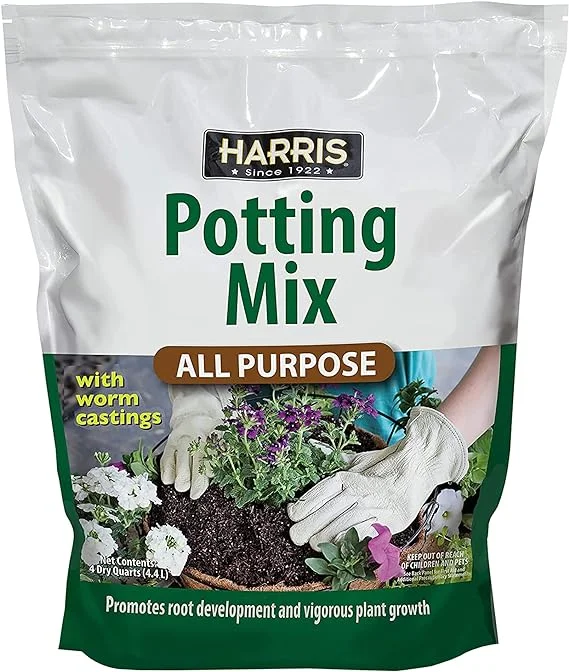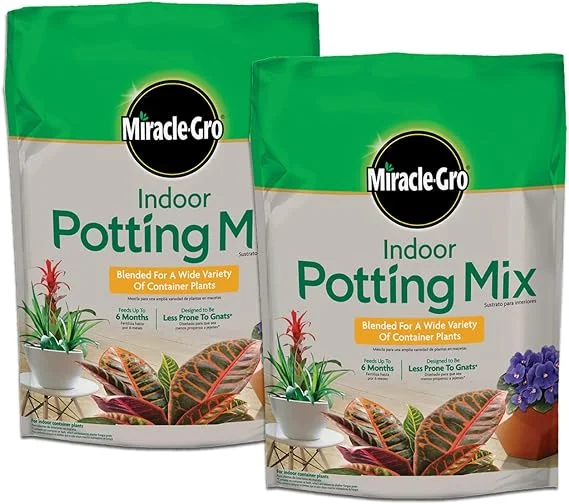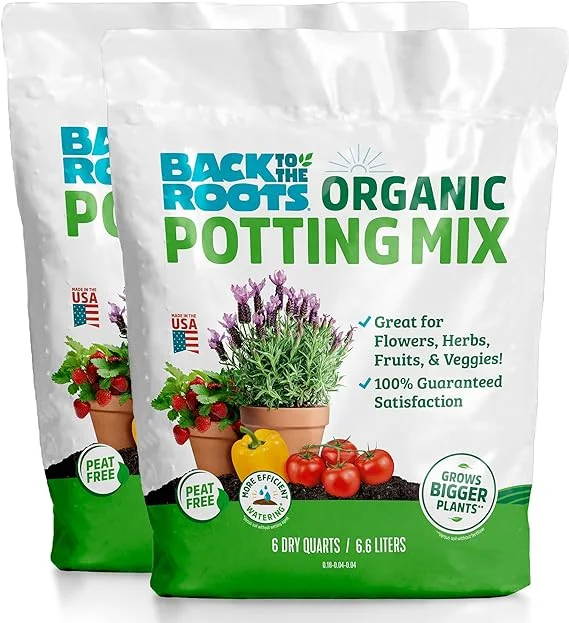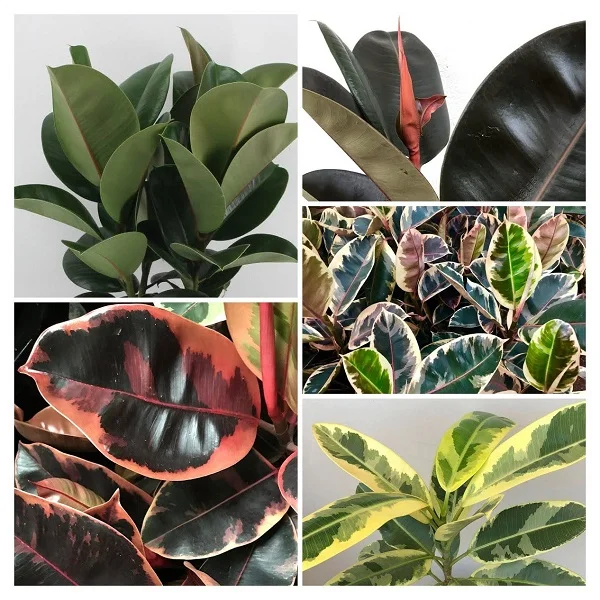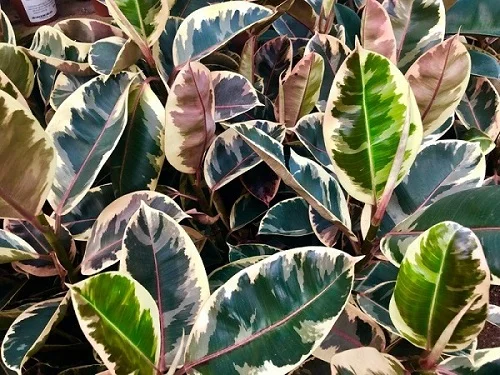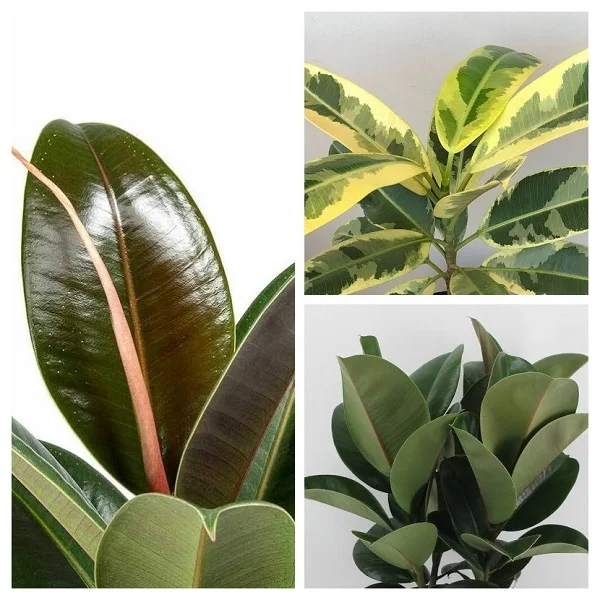How to Grow and Care for Ficus radicans 'Variegata' Indoors
Some links in this post may be affiliate links
Ficus radicans 'Variegata' (Variegated Rooting Fig) prospers in bright light with some direct sunlight, warm and humid conditions, and moderately moist, fertile, well-drained soil coupled with fortnightly feeding in the growing season.
Ficus radicans 'Variegata' is one of the climbing Ficus varieties which bears long, leathery, lance-shaped greyish-green leaves marked with ivory-white edges and long drooping stems.
Being a humidity loving plant, it can be grown in the humid areas in the home like the bathroom, kitchen and laundry area if the lighting is adequate. Ficus radicans variegata is one of the best plants for the bathroom.
Ficus radicans 'Variegata' is ideal for a terrarium as a high humidity can be maintained inside a terrarium, where it can act as a groundcover for the tall plants.
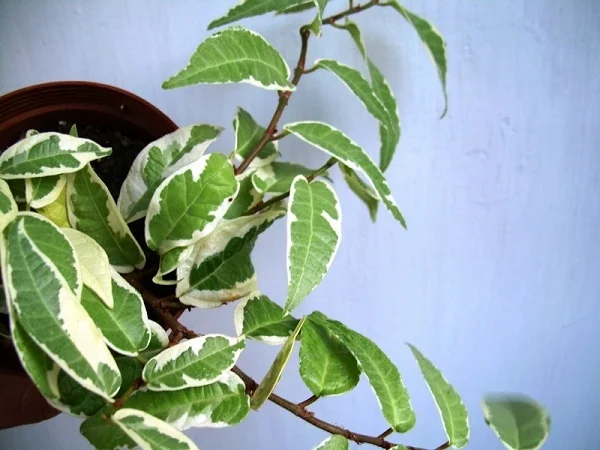
Botanical name: Ficus radicans 'Variegata'
Synonym: Ficus sagittata 'Variegata'
Family: Moraceae
Common names: Variegated Rooting Fig
Origin
Ficus radicans 'Variegata' also called Ficus sagittata 'Variegata' is native to the warm temperate and tropical regions of Asia where it grows as an epiphyte on trees. The Latin specific epithet, 'radicans'. means 'with stems that take root', in reference to the stems which root easily while 'sagittata', means 'arrowed, in the form of an arrow', in reference to the arrow-shaped leaves.
Size
The Variegated Rooting Fig stems can grow 5-6 feet long. The plant is perfect for a hanging basket where the stems can cascade downwards beautifully. It is also ideal for a trellis or moss pole where the stems can climb easily by means of the aerial roots. The plant is among the best plants for hanging baskets.
Toxicity
Like other plants in the Moraceae family, Ficus radicans 'Variegata' is toxic to humans and pets as indicated by Pet Poison Helpline. Ficus plants produce a milky white latex which is an irritant to the eyes and the skin. If ingested it can cause irritation in the mouth, drooling, vomiting, diarrhea, loss of appetite and abdominal pains.
Why grow Ficus radicans 'Variegata' indoors?
- Low maintenance: Requires minimal care once established.
- Fast-growing: Quickly trails over shelves or climbs when given support.
- Versatile display: It can be grown as a hanging plant, climbing vine, or ground cover.
- Attractive variegation: Features striking green and cream-colored leaves that brighten any room.
Where to Buy
Would you like to acquire Ficus radicans 'Variegata' for your collection? You may obtain it online from Etsy (Link to Etsy).
Ficus radicans 'Variegata' Care Indoors
Ficus radicans is a low-maintenance and adaptable houseplant. This guide will cover everything you need to know about growing and maintaining Ficus radicans 'Variegata' indoors, from light and watering needs to soil, propagation, and common problems.
Ficus radicans 'Variegata' flourishes in bright light with 4-6 hours of direct sunlight, average warmth of 15-260C, humidity of 60-70%, and moderately moist, rich, well-drained, all purpose potting soil coupled with fortnightly feeding during the growing season.
Variegated Rooting Fig requires regular pruning to keep it neat and also encourage a bushy growth. Repotting is only needed when it becomes pot-bound. Keep reading for more on these growing conditions and how to achieve them.
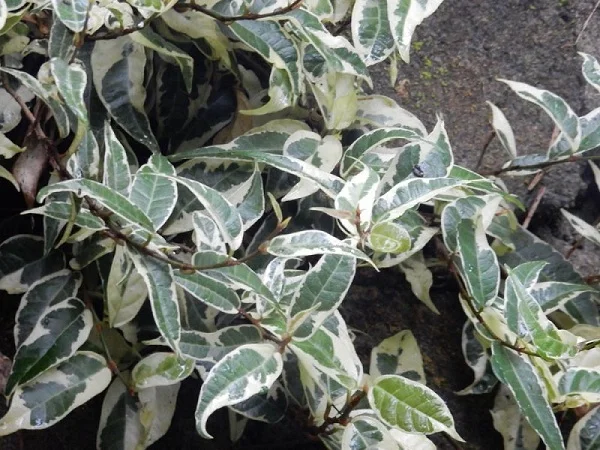
Light Requirements
Variegated Rooting Fig grows best in bright light with at least 4-6 hours of morning or late afternoon sunlight. Avoid exposing it to hot midday sunlight as it can cause brown edges on the leaves.
Ficus radicans 'Variegata' can tolerate lower light conditions. However, if the light is too little it can result in leggy growth and loss of variegation. Therefore, consider investing in a grow light to supplement it.
Turn the pot regularly to ensure that the plant receives light on all sides for uniform growth as well as prevent leggy growth.
Watering
Water Variegated Rooting Fig liberally during the growing season until water comes out through the drainage holes and allow the top 2-3 inches of soil to dry out between waterings. Keep the soil moderately moist and avoid overwatering as it can cause yellowing leaves.
Reduce watering during the cold season to maintain the soil barely moist as growth is minimal at this time. Never allow the soil to dry out completely to avoid curling or dropping leaves.
Use water that is at room temperature to water the plant as cold water can cause reduced growth and leaf drop. Make sure that the pot has a drainage hole to prevent the soil from getting soggy as it can cause root-rot characterized by yellowing leaves and rotting stems.
Ficus radicans 'Variegata' is sensitive to chlorine and other chemicals dissolved in water. Use only chlorine-free water to avoid spots on the leaves. Read more on how to water houseplants correctly.
Temperature and Humidity
The best temperature for Variegated Rooting Fig is an average warmth of 15-260C. Keep it away from drafts to prevent sudden changes in temperature as they can cause reduced growth and leaf drop.
Ficus radicans 'Variegata' requires a humidity of 60-70% to thrive. To raise humidity, set the pot on a wet pebble tray or use a cool mist humidifier. You may also grow the plant in a well-lit bathroom, kitchen, laundry area and other moist areas.
Potting Medium
Variegated Rooting Fig soil should be rich in organic matter and well-drained to prevent it from getting soggy while providing the required nutrients. Most all purpose potting mixes are ideal for the plant.
Fertilizer
Feed Ficus radicans 'Variegata' every 2-3 weeks during the growing season with a balanced, water-soluble fertilizer to promote a lush growth. Do not feed in the cold season as growth is minimal and feeding at this time can cause fertilizer burn.
Repotting
Repot Variegated Rooting Fig at the beginning of the growing season only when it has become root-bound. Avoid frequent repotting as it prefers to be pot-bound. Repot only when it has outgrown its current pot; when roots begin to grow through the drainage holes.
Use a pot 1 size larger and one that has a drainage hole to prevent the soil from getting soggy. Never allow the roots to sit in soggy soil as it can result in leaf drop and root-rot. Check out these pots with drainage holes on Amazon.
For a large Ficus radicans 'Variegata' which may be difficult to handle, annually replenish the top 2-4 inches of soil with fresh soil while taking care not to injure the roots.
Pruning & Grooming
Pruning Variegated Rooting Fig is easy. Remove dead and yellow leaves to maintain the plant neat and also discourage pests and diseases.
When the Ficus radicans 'Variegata' has reached maximum growth or it has become leggy, cutback the branches to rejuvenate growth and also encourage a bushy, compact growth. The foliage emanating from the pruning can be used to propagate new plants.
Regularly clean the leaves by damp-wiping with a soft cloth to get rid of dust and also discourage pest infestation.
Propagation
Ficus radicans 'Variegata' (Variegated Rooting Fig) can be propagated during the growing season from stem-tip cuttings.
Variegated Rooting Fig propagation from stem-tip cuttings
- Take stem-tip cuttings about 6 inches long from a healthy Variegated Rooting Fig. Strip off the lower leaves from the cutting and retain 2-3 leaves on top.
- Allow the sap to dry and then dip the lower cut end cutting in a rooting hormone to hasten rooting.
- Insert the cutting in moist rooting soil. Ensure that the rooting container has adequate drainage to prevent the soil from getting soggy to avoid rotting of the cuttings.
- To enhance rooting of the cutting, create a mini-greenhouse by covering the set up with a clear polythene bag or sheet.
- Ensure that the leaves do not touch the bag or the sheet too much by propping it up with sticks.
- Place the set up in warm, brightly-lit spot and maintain the soil moist through out until new growth emerges.
- New growth indicates that the cutting has rooted. In about 3-4 weeks, rooting will have taken place.
- Gradually over a period of two weeks, remove the plastic cover to acclimatize the new plant.
- In 4-6 months, there will be adequate root development and you can transplant the new plants into individual pots after which you can begin Ficus radicans 'Variegata' routine care.
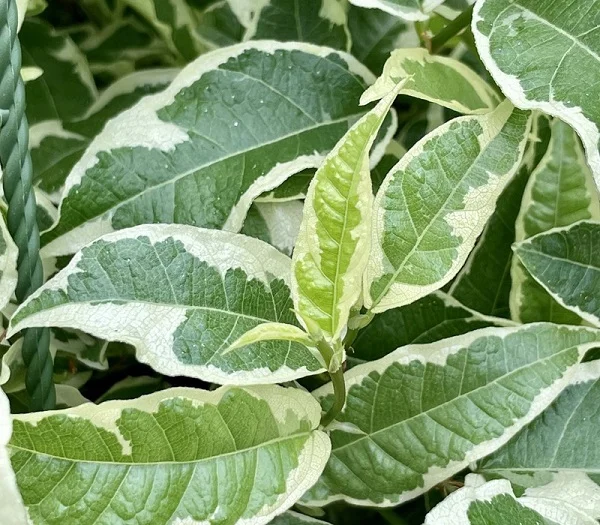
Ficus radicans 'Variegata' Problems with Remedies
Ficus radicans 'Variegata' (Variegated Rooting Fig) common problems include loss of variegation, leaf drop, yellow leaves, brown leaves, drooping leaves, diseases and pests among others. Keeping reading for more details on these problems and how to fix them.
Pests
The common pests in Variegated Rooting Fig are aphids, mealybugs, scales and spider mites. Isolate the affected plant to prevent spread to other plants and treat with neem oil or insecticidal soap as per the manufactuer's recommendations.
Diseases
Variegated Rooting Fig is prone to root-rot which is prevalent in soggy soil. Ensure there is free drainage of both the soil and the pot and also reduce watering during the cold season. Learn how to treat root-rot in houseplants.
Yellow leaves
one of common causes of yellow leaves in Ficus radicans 'Variegata' is overwatering or soggy soil. Allow the top soil to dry out between waterings. Make sure that the soil is well-drained and the pot has a drainage hole.
Leaf drop (loss)
There are many and varied causes of leaf drop in Variegated Rooting Fig. One possible cause of leaf drop is sudden changes in the growing conditions. This is likely to occur when you bring the plant home or when you move it to a new location in the home.
When you bring the Variegated Rooting Fig home, place it in bright light with 4-6 hours of direct morning or late afternoon sunlight and warm conditions. Water it liberally during the growing season while allowing the top 2-3 inches of soil to dry out between waterings. It may loss a few leaves but will eventually settle.
If you need to move the Ficus radicans 'Variegata' to a new location in your home, do so gradually to acclimate it to the new conditions. For instance, if you want to take it outside, move it to a shaded place first before you can take out under bright light.
The second possible cause of leaf drop in Ficus radicans 'Variegata' is extremely cold or hot temperatures due to drafts. The plant requires average temperatures of 15-260C to thrive. Too high or too low temperatures will affect the normal functioning of the plant systems.
Too high temperatures will cause dehydration which can lead to wilting and leaf drop while too low temperatures cause the plant to stop growing and begin to die. Leaf drop is one of the signs of a dying plant. Check out this guide on understanding temperature for houseplants.
The third possible cause of leaf drop in Variegated Rooting Fig is too little light The plant requires bright light with some direct sunlight for optimum growth. Move the plant to a brighter spot and ensure it is receiving bright light with 4-6 hours of direct sunshine or instal a grow light where natural lighting is not sufficient.
Related: 14 reasons why Rubber Plant is dropping leaves and how to fix them
Drooping leaves
Drooping leaves in Variegated Rooting Fig are due to a number of varied reasons. One reason is incorrect watering; either underwatering or overwatering. Water the plant liberally during the growing season while allowing the top 2-3 inches of soil to dry out between waterings. Reduce watering during the cold season but do not allow the soil to dry out completely; maintain the soil moderately moist.
Related: 13 Reasons Why Rubber Plant Leaves are Drooping & How to Fix Them
Loss of leaf variegation
Loss of variegation in Variegated Rooting Fig is due to too little light as it requires bright light with some direct sunlight for optimum growth and cannot tolerate low light. Move the plant to a brighter spot or instal a grow light where the natural lighting is not sufficient. Check out this guide on understanding light for houseplants.
Brown leaf tips and edges
Variegated Rooting Fig requires high humidity to thrive. If the humidity is too low it responds with brown leaf tips and edges. Set the pot on a wet pebble tray or use a cool mist humidifier to elevate humidity. You may also grow the plant in the moist areas in the home like the bathroom, kitchen, laundy area and others if the lighting is adequate.
Conclusion
Ficus radicans 'Variegata' is a low-maintenance, fast-growing, and visually stunning houseplant. Whether displayed as a trailing plant, climbing vine, or decorative ground cover, it thrives with proper care. By following these indoor care tips, you can enjoy a healthy and thriving Ficus radicans 'Variegata'.
Frequently Asked Questions
1. How much sunlight does Ficus radicans 'Variegata' need?
Ficus radicans 'Variegata' thrives in bright, indirect light but can tolerate some shade.
2. How often should I water Variegated Climbing Fig?
Water your Variegated Climbing Fig when the top 1–2 inches of soil are dry. Avoid overwatering.
3. Can Ficus radicans grow in low light?
Ficus radicans can survive in moderate light, but too little light may cause loss of variegation and slow growth.
4. Why are my Ficus radicans leaves turning yellow?
Yellowing is often due to overwatering or poor drainage. Ensure the soil dries slightly between waterings.
5. Is Ficus radicans 'Variegata' toxic to pets?
Yes, Ficus radicans 'Variegata' are mildly toxic to pets if ingested. Keep them out of reach of cats and dogs.
6. How fast does Ficus radicans grow?
Ficus radicans has a fast growth rate and can quickly trail or climb in the right conditions.
You liked it? Share on social media.
Related Content
Amazon Associates Disclosure
Homeplantsguide.com is a participant in the Amazon Services LLC Associates Program, an affiliate advertising program designed to provide a means for sites to earn advertising fees by advertising and linking to amazon.com.
